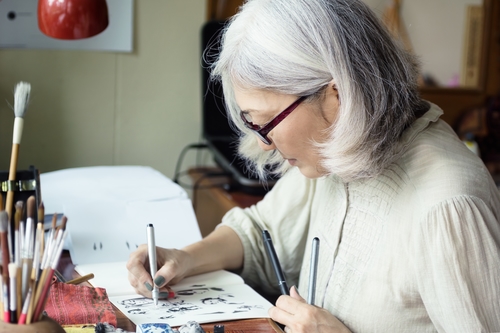Memory Care: Artwork in Alzheimer’s Therapy
by Melrose GardensMemory Care: Artwork in Alzheimer’s Therapy
Alzheimer’s is a disease that affects the brain. The action of the disease on a patient can be predicted as it progresses. The origin is in the hippocampus. This is the part of the brain that creates memories from experiences. The disease gradually spreads from the hippocampus to the front of the brain which is where decision making and language processing occurs. Next, the disease affects the logic center of the brain which is in charge of problem solving. However, emotions and creativity of Alzheimer patients do not get affected for a long time. Since these creative abilities of patients are unaffected by the disease, finding creative ways that can be used by patients to express themselves can show rewarding progress. When patients communicate in these creative ways rather than verbal communications which they struggle with, the patient’s disease becomes less obvious and communications become much more successful.
What is art therapy?
Art therapy can be a great way for an Alzheimer’s patient to express themselves in a way that family and caregivers can understand. Art therapy is the therapeutic use of art making by people who experience an illness, trauma or challenges in living. This can help patients cope with symptoms, help patients express themselves, and develop their cognitive abilities while enjoying life through making art.

Club Melrose and The Cottages Memory Care
Club Melrose and The Cottages are memory care programs at Melrose Gardens. These programs involve a Brain Workout Program developed by the Neurodevelopmental Learning Institute, daily memory enhancement group programs, and mental exercises. These studies which examine the use of art therapy in memory care and Alzheimer’s care are great endorsements of the memory care programs at Melrose Gardens.
Art Therapy Helps Enhance Communication
According to studies, art therapy is identified as a way to enhance communication, functionality of the brain and social interactions. Visual art is found to activate certain memories and emotions that are subdued in patients, motivating conversations when normally these patients are struggling to express how they feel. Even though art therapy does not cure the illness, it can help in stimulating the brain in new ways.
Art Therapy is a Valuable Addition to Memory Care Programs
With the increase in awareness among people about Alzheimer’s disease, many senior communities as well as caregivers alike, tend to incorporate art into the patients’ lives. Providing a nonverbal form of expressing oneself, art therapy enables patients to release negative emotions and relieve symptoms that makes their lives difficult. This can greatly improve quality of life. The temporal lobe is in charge of object recognition and expression via language. The parietal lobe controls fine motor functions and understanding of the position of objects in the environment.
Both these organs are stimulated during art therapy, enabling the patients to have better spatial awareness and capacitate the fine motor movements as well as helping them through communication difficulties by improving the language capabilities. Some Alzheimer’s programs provide art classes that are available for caregivers and seniors to benefit together. Other methods such as creating scrap books will allow patients to cherish their past memories while improving the quality of life. Engaging in such artistic activities can reduce the negative emotions of patients drastically while allowing them to obtain a sense of achievement and joy. In addition, art therapy induces self-control, helps patients to focus and have a peaceful mind and also help improve their cognitive abilities as well as to get back some of the fine motor movements, greatly improving the patients quality of life.
To learn more about our memory care program, please contact us or schedule a tour to visit our assisted living community in Los Angeles.
If you have a family member who is experiencing memory loss or symptoms of Alzheimer’s, and they’re not able to express themselves as clearly or definitively as they’re accustomed to, please consider how a memory care program might help.
References:
Wegerer, J., Stevenson, S. (2017). How Art Helps Dementia Patients. [online] Aplaceformom.com. Available at: https://www.aplaceformom.com/blog/2013-8-3-art-therapy-dementia/ [Accessed 19 Nov. 2017].
Schmid, J. (2017). Art Therapy for Alzheimer's and Dementia. [online] Best Alzheimer's Products. Available at: http://www.best-alzheimers-products.com/art-therapy-for-alzheimers.html [Accessed 19 Nov. 2017].
Wang, Q. and Li, D. (2017). Advances in art therapy for patients with dementia.
